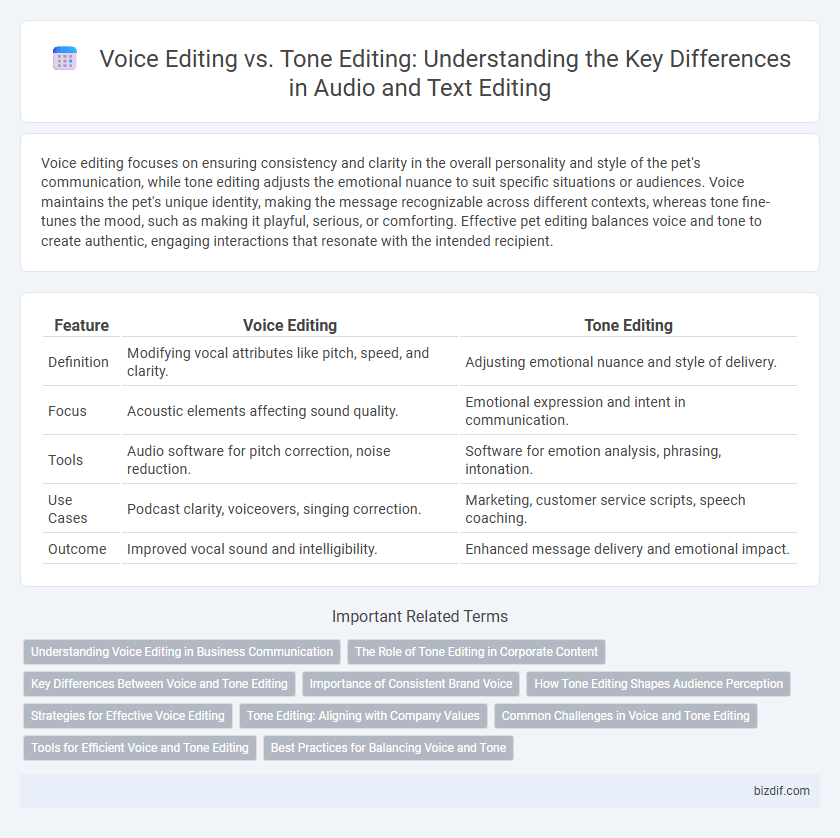Voice editing focuses on ensuring consistency and clarity in the overall personality and style of the pet's communication, while tone editing adjusts the emotional nuance to suit specific situations or audiences. Voice maintains the pet's unique identity, making the message recognizable across different contexts, whereas tone fine-tunes the mood, such as making it playful, serious, or comforting. Effective pet editing balances voice and tone to create authentic, engaging interactions that resonate with the intended recipient.
Table of Comparison
| Feature | Voice Editing | Tone Editing |
|---|---|---|
| Definition | Modifying vocal attributes like pitch, speed, and clarity. | Adjusting emotional nuance and style of delivery. |
| Focus | Acoustic elements affecting sound quality. | Emotional expression and intent in communication. |
| Tools | Audio software for pitch correction, noise reduction. | Software for emotion analysis, phrasing, intonation. |
| Use Cases | Podcast clarity, voiceovers, singing correction. | Marketing, customer service scripts, speech coaching. |
| Outcome | Improved vocal sound and intelligibility. | Enhanced message delivery and emotional impact. |
Understanding Voice Editing in Business Communication
Voice editing in business communication involves refining the unique personality and style that a brand or individual projects through their written or spoken content. It ensures consistency in language, vocabulary, and expression to reinforce the brand's identity and build trust with the target audience. By contrast, tone editing adjusts the emotional inflection to suit different contexts or audience sensitivities, but voice editing maintains the core character that distinguishes the communicator.
The Role of Tone Editing in Corporate Content
Tone editing plays a crucial role in shaping corporate content by aligning the message with the brand's identity and target audience preferences. Unlike voice editing, which focuses on grammatical accuracy and clarity, tone editing ensures that the emotional impact and style of communication reflect professionalism and strategic intent. Effective tone editing enhances corporate credibility, fosters customer trust, and strengthens brand consistency across all communication channels.
Key Differences Between Voice and Tone Editing
Voice editing focuses on refining an author's unique style, personality, and consistent narrative presence, ensuring the text reflects a distinct, authentic voice. Tone editing adjusts the emotional nuance and attitude conveyed, tailoring the language to suit the target audience and desired impact. Key differences include voice editing's emphasis on individuality and character development, while tone editing prioritizes mood, formality, and appropriateness for context.
Importance of Consistent Brand Voice
Consistent brand voice is crucial in editing because voice editing ensures the overall personality and style of the brand remain uniform across all content. Tone editing adjusts the emotional inflection to suit specific contexts without altering the core voice, maintaining audience trust and recognition. Together, they create a cohesive brand experience that strengthens brand identity and engagement.
How Tone Editing Shapes Audience Perception
Tone editing crucially shapes audience perception by adjusting the emotional quality and attitude conveyed in the content, making messages resonate more authentically with target audiences. Unlike voice editing, which focuses on clarity and consistency of the narrator's style, tone editing fine-tunes nuances such as warmth, formality, or urgency to influence how the information is received and interpreted. Effective tone editing enhances engagement and trust, aligning communications with brand identity and cultural expectations.
Strategies for Effective Voice Editing
Effective voice editing requires preserving the author's unique style while enhancing clarity and flow, ensuring the narrative voice remains consistent and engaging. Strategies include pinpointing redundant phrases, adjusting sentence structures for rhythm, and emphasizing active voice to maintain reader interest. Balancing these elements helps refine the manuscript without compromising the distinctive personality conveyed through the text.
Tone Editing: Aligning with Company Values
Tone editing enhances content by ensuring language reflects the company's core values and brand identity, fostering trust and consistency across communications. It involves adjusting word choice, sentence structure, and style to evoke the desired emotional response aligned with corporate culture. This careful alignment strengthens audience connection and reinforces the company's mission in every message.
Common Challenges in Voice and Tone Editing
Voice editing often struggles with maintaining consistency in character identity while ensuring clarity and engagement, whereas tone editing faces challenges in adapting the emotional resonance to suit diverse audiences without diluting the message's intent. Both voice and tone editing require careful attention to context, audience expectations, and the subtle nuances of language to prevent misinterpretation or loss of original voice. Common challenges include balancing authenticity with readability, managing stylistic variations, and preserving the writer's unique expression throughout the editing process.
Tools for Efficient Voice and Tone Editing
Voice editing tools like Adobe Audition and Audacity enable precise control over pitch, volume, and clarity to enhance vocal quality. Tone editing software such as Grammarly and Hemingway Editor analyze and adjust the emotional impact, style, and formality of the text to align with the desired audience response. Combining these tools ensures efficient refinement of both vocal attributes and written tone for professional communication.
Best Practices for Balancing Voice and Tone
Balancing voice and tone in editing requires a clear understanding of the author's unique style and the target audience's expectations. Voice editing focuses on maintaining consistent character or author personality, while tone editing adjusts the emotional impact and attitude conveyed in the text. Best practices include iterative reviews to ensure that voice authenticity remains intact while tone aligns with the intended message and context.
Voice Editing vs Tone Editing Infographic

 bizdif.com
bizdif.com